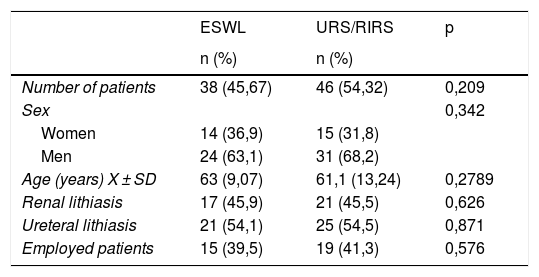To perform a comparative analysis of indirect and direct costs of two minimally invasive techniques (extracorporeal shock wave lithotripsy (ESWL) vs. ureteroscopy with holmium laser (URS/RIRS)) for the treatment of renal/ureteral calculi smaller than 2 cm.
Material and methodsProspective, comparative, non-randomized study of 84 patients treated for kidney stones smaller than 2 cm between January and December 2016. Of these, 38 (45.67%) were treated with ESWL (18 renal lithiasis and 20 ureteral lithiasis) and 46 (54.32%) with URS/RIRS (22 renal lithiasis and 24 ureteral lithiasis). A total of 19 (41.3%) patients in the URS/RIRS group and 15 (39.5%) patients in the ESWL group were actively working before treatment. The variables analyzed were sex, age, number and size of lithiasis, time (days) off from work due to treatment, estimate of indirect cost due to labor productivity loss and direct treatment costs including follow-up (total number of procedures, ancillary care, visits and diagnostic tests). The 2015 Wage Structure Survey (INE) was used to estimate the indirect cost. In addition, the “Work Productivity and Activity Impairment” (WPAI) questionnaire was also used to determine the level of perceived productivity loss.
ResultsThe mean number of sessions until lithiasis resolution was achieved was 2.57 for the ESWL group and 1.04 for the URS. The mean number of days off from work in the URS group was 7.16 days and 3.18 (p = 0.034) in the ESWL group. The total indirect costs resulting from productivity loss were EUR 621.55 and EUR 276.05 for the URS and ESWL, respectively. Direct costs in the ESWL group were EUR 1382.9 and EUR 2317.71 in the URS group. The level of work impairment perceived by patients undergoing URS was 18.88% and 21.33% in the ESWL group. The degree of impairment for performing activities of daily living was 24.44% in the URS and 15% in ESWL.
ConclusionsThe ESWL technique requires a higher number of sessions for the resolution of kidney stones under 2 cm, but it has a lower impact on total costs and on the perceived degree of affectation.
Analizar de forma comparativa los costes indirectos y directos de dos técnicas mínimamente invasivas (litotricia extracorpórea (LEOC) vs ureterorrenoscopia-láser holmium (URS/RIRS)) para el tratamiento de la litiasis reno-ureteral menor de 2 cm.
Material y métodosEstudio prospectivo y comparativo, no aleatorizado de 84 pacientes tratados por litiasis reno-ureteral menor de 2 cm entre enero y diciembre de 2016. De estos, 38 (45,67%) se trataron con LEOC (18 litiasis renales y 20 litiasis ureterales) y 46 (54,32%) con URS/RIRS (22 litiasis renal y 24 litiasis ureteral). Un total de 19 (41,3%) pacientes estaban activos laboralmente en el grupo de URS/RIRS y 15 (39,5%) pacientes en el grupo de LEOC. Las variables analizadas fueron sexo, edad, número y tamaño de las litiasis, días de baja laboral debido al tratamiento, estimación del coste indirecto por la pérdida de productividad laboral y el coste directo del tratamiento aplicado incluyendo el seguimiento (número total de procedimientos, procedimientos auxiliares, visitas y pruebas diagnósticas). Para la estimación del coste indirecto se empleó la Encuesta de Estructura Salarial 2015 (INE). Además también se utilizó el cuestionario “Work Productivity and Activity Impairment” (WPAI) para determinar el grado de percepción de pérdida de productividad.
ResultadosEl número medio de sesiones hasta la resolución de la litiasis fue de 2,57 para el grupo de LEOC y de 1,04 para la URS. El promedio de días de baja laboral en el grupo de la URS fue de 7,16 días, mientras que en el caso de la LEOC fue de 3,18 (p = 0,034). Los costes indirectos totales derivados de la pérdida de productividad fueron de 621,55 euros y de 276,05 euros para la URS y LEOC respectivamente. Los costes directos en el grupo de la LEOC fueron de 1382,9 euros y 2317,71 euros en el grupo de la URS. El grado de afectación en el trabajo percibido por los pacientes sometidos a URS fue del 18,88% y del 21,33% en el grupo de LEOC. El grado de afectación para realizar actividades cotidianas fue del 24,44% en URS y del 15% en LEOC.
Conclusionesla LEOC es una técnica que precisa de un mayor número medio de sesiones para la resolución de la litiasis reno-ureteral menor de 2 cm, pero con una menor repercusión en los costes totales y en la percepción del grado de afectación.










